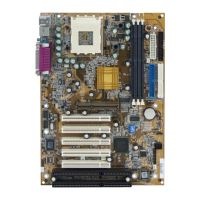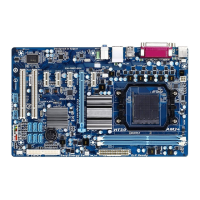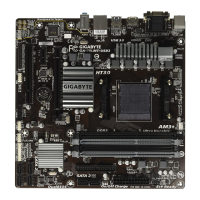Do you have a question about the Gigabyte GA-7ZX and is the answer not in the manual?
Advice for users to correct radio interference issues.
Warning about unauthorized modifications voiding operational authority.
Lists standards and directives the product conforms to for regulatory compliance.
Overview of the motherboard's layout, CPU, chipset, memory, slots, and peripherals.
Instructions for setting the system bus speed using DIP switches and jumpers.
Details and pinouts for audio, serial, and parallel ports on the motherboard.
Pinouts and functions for USB, PS/2 keyboard/mouse, and ATX power connectors.
Details for IDE, modem, AUX, CD audio, and IR connectors.
Identification of connectors for system status LEDs.
Configuration options for system control jumpers like STR and sound selection.
Settings for USB wake-up functions and BIOS write protection.
Procedure for clearing CMOS settings and information about the CMOS battery.
Explanation of Suspend-to-RAM (STR) and steps for its installation.
Methods to enter STR sleep mode and wake the system.
Hardware and software prerequisites for proper STR function.
Explanation of Dual BIOS technology and its benefits for system stability.
Guide to accessing and operating the Dual BIOS utility interface.
Answers to common questions and details on how Dual BIOS works.
Instructions for configuring the four-speaker audio output.
Steps to enable and configure digital audio output via SPDIF.
Overview of Gigabyte's Windows-based BIOS live update utility.
Introduction to Gigabyte's Windows-based system overdrive utility.
Table detailing compatible RAM module sizes and types for installation.
Steps to access the BIOS setup utility and basic navigation controls.
Description of the main menu structure and available configuration categories.
Configuration settings for Standard CMOS, BIOS Features, Chipset, Power Management, Peripherals, Hardware Monitor.
Options for loading defaults, setting passwords, and exiting the BIOS setup.
Settings for DRAM frequency, CAS latency, and AGP modes.
Configuration options for USB controllers and PCI delay transactions.
Settings for BIOS flash protection, DRAM, and bus strengths.
Configuration for SDRAM command, address, CAS#, and RAS# drive strengths.
Settings for ACPI sleep states, USB wake-up, and suspend timeouts.
Controls for display activity, IRQ handling, power button, and AC back behavior.
Configures the system to power on at a scheduled time.
Configuration for Plug and Play OS support, VGA boot, and palette snoop.
Assigns IRQ priorities for PCI slots to optimize resource allocation.
Defines resource usage for specific IRQ lines.
Settings for onboard IDE channels and serial port A.
Configuration for serial port B, duplex mode, and parallel port.
Settings for parallel port DMA/IRQ, and AC97/Legacy audio.
Configuration for Sound Blaster, SB I/O, IRQ, DMA, MPU-401, and Game Port.
Settings for ACPI shutdown temperature and monitoring CPU/System temperature.
Monitoring of CPU fan speed, system fan speed, and system voltages.
Steps for updating the system BIOS using an internet connection.
Instructions for updating the system BIOS without an internet connection.
Procedures for saving current BIOS and checking compatibility.
Advice for users to correct radio interference issues.
Warning about unauthorized modifications voiding operational authority.
Lists standards and directives the product conforms to for regulatory compliance.
Overview of the motherboard's layout, CPU, chipset, memory, slots, and peripherals.
Instructions for setting the system bus speed using DIP switches and jumpers.
Details and pinouts for audio, serial, and parallel ports on the motherboard.
Pinouts and functions for USB, PS/2 keyboard/mouse, and ATX power connectors.
Details for IDE, modem, AUX, CD audio, and IR connectors.
Identification of connectors for system status LEDs.
Configuration options for system control jumpers like STR and sound selection.
Settings for USB wake-up functions and BIOS write protection.
Procedure for clearing CMOS settings and information about the CMOS battery.
Explanation of Suspend-to-RAM (STR) and steps for its installation.
Methods to enter STR sleep mode and wake the system.
Hardware and software prerequisites for proper STR function.
Explanation of Dual BIOS technology and its benefits for system stability.
Guide to accessing and operating the Dual BIOS utility interface.
Answers to common questions and details on how Dual BIOS works.
Instructions for configuring the four-speaker audio output.
Steps to enable and configure digital audio output via SPDIF.
Overview of Gigabyte's Windows-based BIOS live update utility.
Introduction to Gigabyte's Windows-based system overdrive utility.
Table detailing compatible RAM module sizes and types for installation.
Steps to access the BIOS setup utility and basic navigation controls.
Description of the main menu structure and available configuration categories.
Configuration settings for Standard CMOS, BIOS Features, Chipset, Power Management, Peripherals, Hardware Monitor.
Options for loading defaults, setting passwords, and exiting the BIOS setup.
Settings for DRAM frequency, CAS latency, and AGP modes.
Configuration options for USB controllers and PCI delay transactions.
Settings for BIOS flash protection, DRAM, and bus strengths.
Configuration for SDRAM command, address, CAS#, and RAS# drive strengths.
Settings for ACPI sleep states, USB wake-up, and suspend timeouts.
Controls for display activity, IRQ handling, power button, and AC back behavior.
Configures the system to power on at a scheduled time.
Configuration for Plug and Play OS support, VGA boot, and palette snoop.
Assigns IRQ priorities for PCI slots to optimize resource allocation.
Defines resource usage for specific IRQ lines.
Settings for onboard IDE channels and serial port A.
Configuration for serial port B, duplex mode, and parallel port.
Settings for parallel port DMA/IRQ, and AC97/Legacy audio.
Configuration for Sound Blaster, SB I/O, IRQ, DMA, MPU-401, and Game Port.
Settings for ACPI shutdown temperature and monitoring CPU/System temperature.
Monitoring of CPU fan speed, system fan speed, and system voltages.
Steps for updating the system BIOS using an internet connection.
Instructions for updating the system BIOS without an internet connection.
Procedures for saving current BIOS and checking compatibility.
| Form Factor | ATX |
|---|---|
| Socket Type | Socket A |
| Chipset | VIA KT133 |
| Memory Slots | 3 |
| Maximum RAM | 1.5 GB |
| IDE Ports | 2 |
| Memory Type | PC100/PC133 SDRAM |
| USB Ports | 2 (USB 1.1) |
| Audio | AC'97 |
| Supported Processors | AMD Athlon, Duron |












